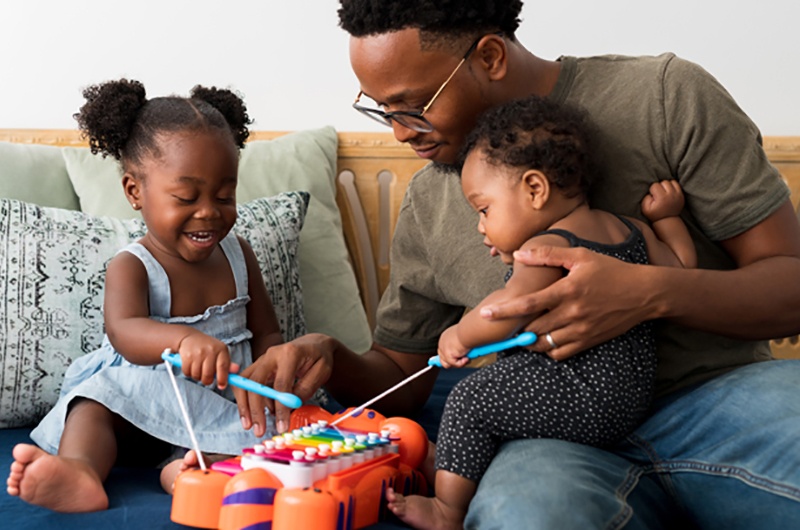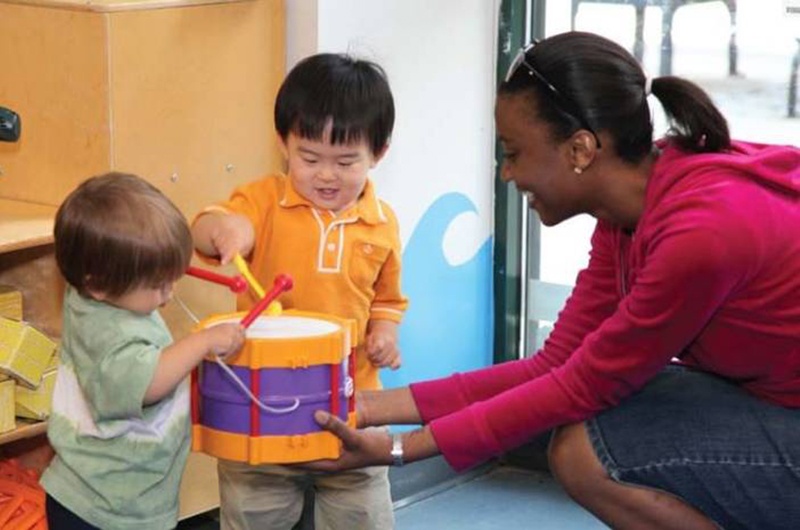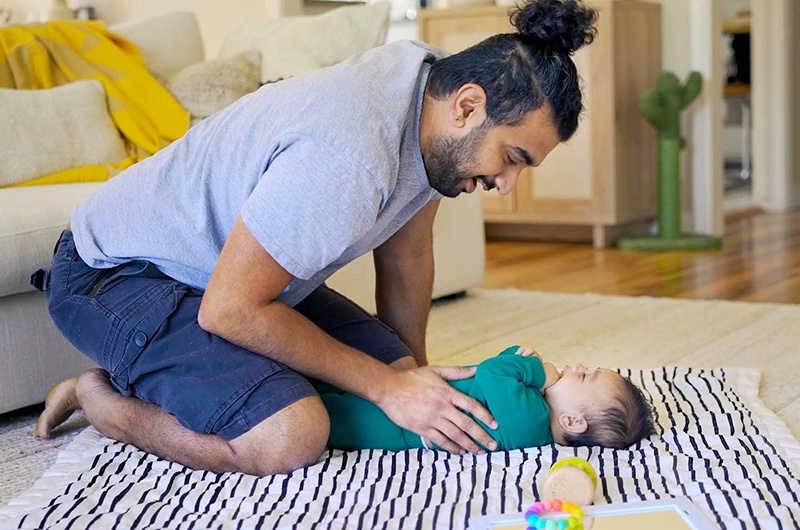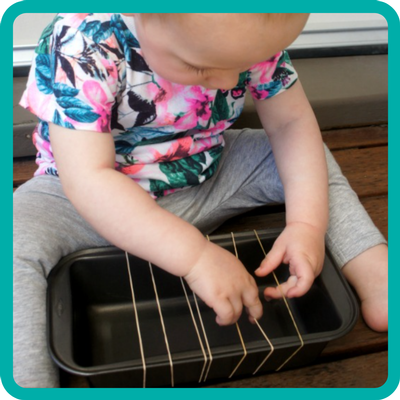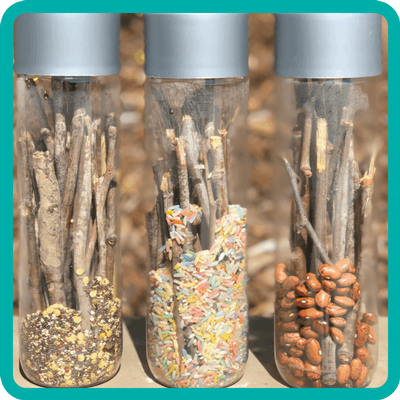Read, Baby, Read is a Free Library initiative focused on encouraging early literacy development among infants and young toddlers under two years old. We work with 12 participating libraries across Philadelphia to reach caregivers of all ages, providing resources that support early literacy skills, language development, and purposeful play. In addition, you can find early literacy tips and resources on our Instagram page @read.baby.read!
Each month, we bring you fun activity ideas with a theme based on the five early literacy practices from Every Child Ready To Read: Read, Sing, Write, Play, and Talk! So far, we’ve explored vehicles, animals, the body, water, food, shapes, feelings, nature, colors, and numbers!
This month is all about music and rhythm!
READ
Many of your favorite songs have been turned into board books that are available in the Free Library’s catalog. It’s easy to place holds online for free and schedule curbside pick-up at many neighborhood libraries. Even if a book isn’t based on a song, if the text is rhythmic you can make it a singing book by creating your own tune!
- Zoom Zoom Zoom by Annie Kubler
This author has a variety of baby-friendly books based on songs, including bilingual versions of your favorite songs: Heads, Shoulders, Knees, and Toes (Spanish), Row, Row, Row Your Boat (French), If You’re Happy and You Know It (Vietnamese), and Wheels on the Bus (Arabic). She also has a "sign and singalong" series featuring baby sign language (Baa Baa Black Sheep, Itsy Bitsy Spider, and Twinkle Twinkle Little Star).
- Five Little Ducks by Child’s Play
For more songbooks with sign language, check out the "Hands On" board book series, also featuring Humpty Dumpty, Jack and Jill, and Wheels on the Bus.
- Baby Beluga by Raffi
Many of Raffi’s famous songs are available as board books! Other Raffi songbooks include Down By The Bay, Wheels on the Bus, Five Little Ducks, and Rise and Shine.
- Row, Row, Row Your Boat by Noisy Crow
The moving sliders in this hands-on book will help your child develop their fine motor skills as you sing along. For other songs in this style of book, check out Hey Diddle Diddle, Twinkle Twinkle Little Star, and Happy Birthday.
- The Itsy Bitsy Spider by Maddie Frost
The "Indestructibles" version of this classic song is chew-proof, rip-proof, non-toxic, and washable!
- See-Saw: First Book of Nursery Songs by Ailie Busby
Instead of just one song, this board book features a collection of several well-known children’s songs. (Read, Baby, Read tip: You don’t have to read the whole book at once! You can pick and choose which songs to read and skip.)
- Old MacDonald Had a Truck by Steve Goetz
This updated version of a children’s classic features all of your child’s favorite trucks. Also, try Old Macdonald Had A Boat from the same author.
- Blue Moo: 17 Jukebox Hits From Way Back Never by Sandra Boynton
You don’t have to stick to familiar songs – this combination book and CD features silly original songs! Also check out Boyton’s other book/CD combo, Hog Wild: A Frenzy of Dance Music.
SING
There’s no better (or easier) way to explore music with your child than by singing, and fortunately, there are lots of benefits to singing together. Songs encourage bonding and build literacy skills. If you’ve ever been to a baby storytime, you’ll even notice that there are often more songs than books. Don’t worry if you don’t have a good singing voice, your baby still loves to hear you sing! Looking for new songs to sing with your baby? Jbrary is an excellent resource for finding children’s songs. They offer different themed playlists with a variety of lap bounces, tickles, and action songs that are perfect for babies and toddlers. They even have instrument-friendly playlists specifically devoted to music and rhythm, such as their rhythm sticks playlist or egg shaker playlist. Instruments are a great addition to song time with your little one. They encourage your child to develop rhythm skills while also honing their fine motor muscles (the muscles of their hands). You can watch Sarah use instruments for the song “Shake Your Sillies Out” (another excellent song choice for exploring rhythm) on our Instagram storytime channel.
PLAY
Playing with instruments is a great way to incorporate music and play. Being able to make their own music through the use of instruments helps boost children’s brain development. Making music also helps the body and mind work together, encourages social interaction, and stimulates creativity. The best part is you can make your own instruments using items you have around the house! We love making shaker eggs out of plastic Easter eggs. Empty containers are great for rain sticks, shakers, and noisemakers. Paper plates can become a tambourine or a banjo. Cardboard tubes can be used to make a trumpet, kazoo, or xylophone. Use popsicle sticks to make a harmonica or rubber bands to make a baby guitar. Create maracas out of spoons, egg cartons, or a whisk. And you don’t even need to D-I-Y anything to explore music at home. You can take everyday household objects and experiment with the noises they make. Have a wooden spoon and a pot or pan? You’ve got yourself a drum! Bang two pot lids together to make cymbals. If you have a jar of popcorn kernels or a box of pasta, try shaking it like a rainstick. The possibilities for making music are endless, and you don’t even need to leave the house.
WRITE
Art is a great way to let your baby "write," whether that’s using crayons, paintbrushes, or simply their fingers. You can incorporate music into the art experience by playing music in the background while your child draws or paints. Music has lots of developmental benefits, and simply listening to music can stimulate your child’s creativity. Try different genres of music to see if that affects your child’s style or approach. Don’t be surprised if toddlers start dancing as they draw! The Free Library has lots of children’s music available to borrow on CD if you need something to play. Alternatively, you can sing songs while making art. Singing songs about color, for instance, is a great option when you’re doing an art project that involves color mixing. Think of ways to turn your favorite song into an art activity, such as painting with toy animals to the tune of "Old MacDonald" or painting with toy vehicles to the tune of "Wheels on the Bus."
TALK
Singing and talking go hand-in-hand. The reason music helps children with literacy is that learning the rhythm of music also helps them learn the rhythm of speech, since both have strong rhythmic patterns. Children are also learning the rhythm of conversation when you talk to them. This is why the model of "serve and return" is so helpful for talking to babies. "Serve and return" involves acting through the parts of a real conversation with your baby, even if they aren’t yet verbal. When you ask your baby a question, give them time to respond even if you know they won’t verbally respond. This teaches them the rhythm of conversation.
Another reason music is so important for literacy is that songs slow down language. Each syllable has its own beat and the words are elongated. This makes it easier for babies to understand and absorb the words they’re hearing. The same effect can be achieved by talking in "parentese." Not to be confused with baby talk (which is when adults use nonsense words like "goo goo ga ga"), parentese is when adults use real words but speak in a sing-songy voice—enunciating the letters, elongating the words, and using a higher pitch. Like singing, it slows down language so that babies can hear each individual sound better, which makes it easier for them to learn new words!
Be sure to follow us on Instagram for daily tips and resources about early literacy as well as weekly virtual baby storytimes. And stay tuned for next month’s installment of this blog series with a brand new theme!
Read, Baby, Read’s team includes Early Childhood Specialists Sarah Jacknis and Natasha Smith.
Read, Baby, Read is made possible by a generous grant from the William Penn Foundation.
Have a question for Free Library staff? Please submit it to our Ask a Librarian page and receive a response within two business days.


